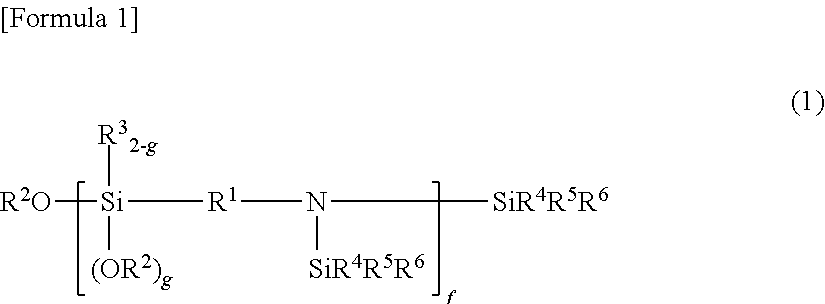Method for producing modified conjugated diene based (CO)polymer, modified conjugated diene based (CO)polymer, and rubber composition
a conjugated diene and polymer technology, applied in the field of methods for producing modified conjugated diene based (co) polymers, modified conjugated diene based polymers and rubber compositions, can solve the problems of low mooney viscosity, low shape stability, change of shape, etc., and achieve excellent shape stability, high mooney viscosity, good processability
- Summary
- Abstract
- Description
- Claims
- Application Information
AI Technical Summary
Benefits of technology
Problems solved by technology
Method used
Image
Examples
example 1
[0110]Into a 5-liter (internal volume) autoclave reactor purged with nitrogen were fed 2,500 g of cyclohexane, 25 g of tetrahydrofuran, 100 g of styrene and 390 g of 1,3-butadiene. The temperature of the reactor contents was controlled at 10° C. and then 335 mg of n-butyl lithium was added to initiate polymerization. The polymerization was conducted under an adiabatic condition and the maximum temperature reached 85° C. When the polymerization conversion reached 99% (after 26 minutes from the start of polymerization), additional 10 g of 1,3-butadiene was added in 2 minutes and polymerization was conducted for 3 minutes. Then, 1,400 mg of N,N-bis(trimethylsilyl)aminopropylmethyldiethoxysilane was added and a reaction was conducted for 15 minutes to obtain a polymer solution containing a conjugated diene based (co)polymer. The conjugated diene based (co)polymer had a before-modification peak molecular weight of 200,000.
[0111]Incidentally, whether or not the N,N-bis(trimethylsilyl)amin...
example 2
[0113]Into a 5-liter (internal volume) autoclave reactor purged with nitrogen were fed 2,500 g of cyclohexane, 25 g of tetrahydrofuran, 100 g of styrene and 390 g of 1,3-butadiene. The temperature of the reactor contents was controlled at 10° C. and then 335 mg of n-butyl lithium was added to initiate polymerization. The polymerization was conducted under an adiabatic condition and the maximum temperature reached 85° C. When the polymerization conversion reached 990 (after 26 minutes from the start of polymerization), additional 10 g of 1,3-butadiene was added in 2 minutes and polymerization was conducted for 3 minutes. Then, 1,400 mg of N,N-bis(trimethylsilyl)aminopropylmethyldiethoxysilane was added and a reaction was conducted for 15 minutes. To the polymer solution after the reaction was added 2,6-di-tert-butyl-p-cresol to obtain a polymer solution containing a conjugated diene based (co)polymer. The conjugated diene based (co)polymer had a before-modification peak molecular wei...
example 3
[0115]Into a 5-liter (internal volume) autoclave reactor purged with nitrogen were fed 2,500 g of cyclohexane, 25 g of tetrahydrofuran, 100 g of styrene and 390 g of 1,3-butadiene. The temperature of the reactor contents was controlled at 10° C. and then 335 mg of n-butyl lithium was added to initiate polymerization. The polymerization was conducted under an adiabatic condition and the maximum temperature reached 85° C. When the polymerization conversion reached 99% (after 26 minutes from the start of polymerization), additional 10 g of 1,3-butadiene was added in 2 minutes and polymerization was conducted for 3 minutes. Then, 1,400 mg of N,N-bis(trimethylsilyl)aminopropylmethyldiethoxysilane was added and a reaction was conducted for 15 minutes. To the polymer solution after the reaction was added 2,6-di-tert-butyl-p-cresol. Then, steam stripping was conducted for solvent removal, followed by drying on a hot roll of 110° C., to obtain a conjugated diene based (co)polymer.
[0116]The o...
PUM
| Property | Measurement | Unit |
|---|---|---|
| mass | aaaaa | aaaaa |
| Mooney viscosity | aaaaa | aaaaa |
| shape stability | aaaaa | aaaaa |
Abstract
Description
Claims
Application Information
 Login to View More
Login to View More - R&D
- Intellectual Property
- Life Sciences
- Materials
- Tech Scout
- Unparalleled Data Quality
- Higher Quality Content
- 60% Fewer Hallucinations
Browse by: Latest US Patents, China's latest patents, Technical Efficacy Thesaurus, Application Domain, Technology Topic, Popular Technical Reports.
© 2025 PatSnap. All rights reserved.Legal|Privacy policy|Modern Slavery Act Transparency Statement|Sitemap|About US| Contact US: help@patsnap.com



